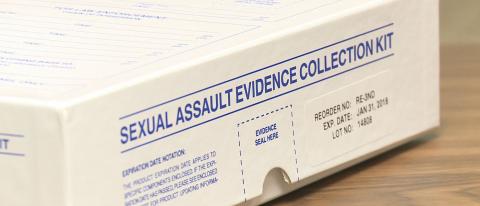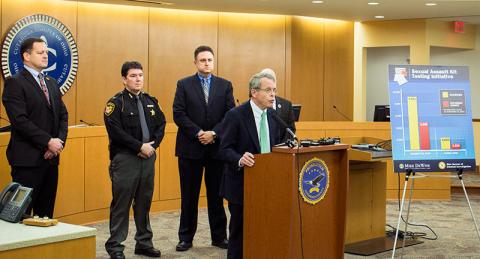When Cuyahoga County, Ohio, embarked on the testing of nearly 7,000 backlogged sexual assault kits (SAKs) in early 2013, metaphors from Greek and Roman mythology abounded in the Cleveland media coverage – 'Herculean task' and 'Pandora's box' chief among them.
Five years on, now that the backlog has been largely cleared, the sense of dread associated with those words has been replaced by one of discovery attached to a very American term: gold mine.
Setting aside for a moment the successes of the county's SAK Task Force, which conducted the tests — 377 convictions, a 92.4 percent conviction rate, identification of 804 serial sex offenders, and justice at last for hundreds of area victims (as of September 2018) — what really stands out in task force members' minds is what they didn't expect: research findings showing that all rapes should be investigated as the work of serial offenders and that investigators' reliance on traditional criminal patterns should be contested; the benefit of making rape investigations victim-centered; and the value of taking advantage of stakeholder partnerships that had been in place nominally but never leveraged to full effect.
Ultimately, the task force showed Cleveland and the rest of the county what public good can be done by a well-resourced, interagency investigative body backed by research, the latest technology and, especially, determined leadership at the highest levels of state government. With such support, the benefits of unintended consequences, chiefly the opportunity to undo ineffective past practices, can take root in local law enforcement and result in more efficient and effective work on behalf of citizens. It's the kind of research-driven investigative work that gets the attention of law enforcement agencies nationwide.
A little history
The story of Cuyahoga County's unsubmitted SAKs begins on Halloween 2009, when Cleveland police discovered the remains of 11 women in the home of serial killer Anthony Sowell. The subsequent investigation revealed that the CPD had failed to follow up on several crime reports that might have prevented the Sowell murders. As a result, Cleveland began to review its policies and procedures for investigating missing person and sexual assault cases.
It also placed the city squarely in a rising current of American cities with backlogs of unsubmitted SAKs, dating back to 1999 reports that New York City had more than 16,000 kits that had been collected from victims but never tested. Amid growing public outrage, similar reports followed from Los Angeles, Houston, Detroit, New Orleans, and other urban areas, until a 2004 survey by the National Institute of Justice estimated that, nationwide, 169,000 rape cases dating back to 1982 contained untested biological evidence.
What each state did about its backlog depended largely on its law enforcement leadership. Ohio's was determined to get to the bottom of the issue: In late 2011, Attorney General Mike DeWine invited all state law enforcement agencies to submit untested SAKs to the state's Bureau of Criminal Investigation (BCI), and in February 2013, then-Cuyahoga County Prosecutor Timothy McGinty ordered a team — now known as the Cuyahoga County SAK Task Force — to collect, test, investigate, and prosecute cases that arose from the newly-tested SAKs. By 2015, 4,845 SAKs from Cuyahoga County, dating from 1993 to 2009, had been submitted to the BCI for testing.
Sexual Assault Kit Initiative
Making best use of the results would not come on the cheap, however – not with such a mountain of evidence and a task force comprising the prosecutor's office, BCI, CPD's Sex Crimes Unit, the Cuyahoga County Sheriff's Office, and the Cleveland Rape Crisis Center. In 2015, the prosecutor's office applied for and received the first of four Bureau of Justice Assistance (BJA) grants from the bureau's Sexual Assault Kit Initiative (SAKI), totaling $7 million.
SAKI takes a flexible approach to unsubmitted kits, aligning grants to the stage in the process where applicants find themselves. Funds can support efforts to inventory SAKs, test them, assign personnel to investigate and prosecute leads resulting from them, support victims, develop tracking systems, train law enforcement on sexual assault investigations, and conduct research on testing outcomes. Another SAKI funding stream supports the collection of 'lawfully owed DNA' – samples that have not been collected from offenders who lawfully "owe" their DNA. One of Cuyahoga County's three BJA grants, for $1 million, was used for this purpose, enabling the county to address nearly 16,000 missing DNA profiles. To date, it has resulted in 22 hits in the Combined DNA Index System (CODIS), including some for murder and rape.
Angela Williamson, who manages SAKI for BJA, said Cuyahoga County was an "advanced site" which had already tested most of its SAKs by the time of the first BJA grant; therefore, the 2015 and 2016 funding focused on investigations and prosecutions, the "areas of greatest need" for the county.
And while most of the grant funding went to the county prosecutor's office, some went to Case Western Reserve University (CWRU) in Cleveland to draw lessons from the SAKs' testing. This is when Cuyahoga County's effort entered its gold mine phase.
"We didn't know this would be a gold mine, but that's what it became," said CWRU Senior Research Associate Rachel Lovell, who spearheaded the research. "What we learned was, with DNA testing, looking backwards can tell a whole lot about moving forward."
Challenging traditional assumptions about sexual assault
What made the SAKs' findings so valuable, Lovell wrote in the Journal of Criminal Justice in 2017, was that, previously, "Most of what is known about serial sex offenders [had been] based on offenders who have been convicted of multiple sexual assaults where the offender has been "caught," or offenders who self-report multiple assaults. In the former, convicted serial sex offenders represent a very small and skewed proportion of all sexual offenders, as convictions for sexual assault are the exception rather than the rule. Additionally, self-reported multiple offending has the inherent issue of relying on the offender to recall, disclose, and self-define more than one of their sexual acts as nonconsensual. Our data, on the other hand, pulls from a large sample of sexual assaults with unsubmitted SAKs over a 20-year span of time and these linkages across offenses are more objectively connected."
And the resulting research by CWRU was eye-opening. Among its findings:
- Law enforcement should investigate each sexual assault as if it were potentially perpetrated by a serial sex offender, as it is likely that a sexual offender has either previously sexually assaulted or will offend again in the future.
- Serial sex offenders have traditionally been investigated according to the consistency of their offending pattern; yet, findings suggest that serial sex offenders exhibit a great deal of versatility in their offending, which means that a "traditional" offending pattern or modus operandi (e.g., who they assault, where they assault, how they assault, etc.) is likely not a reliable link across sexual assaults.
- While there are some statistically significant differences between nonserial and serial sex offenders, none of these variables are consistent enough across crime scenes to allow an analyst to predict whether any particular crime is the work of a nonserial or a serial sex offender.
The second finding in particular got Lovell's attention: "Sexual predators are more opportunistic than we thought, based on the crossover we discovered. By that we mean that they often mix their victims – the same predator who assaults a teenaged girl may also assault someone elderly, or across racial or even gender lines. Exploiting victims' vulnerabilities became more of a common thread than other variables."
As a result of the findings, researchers recommended that Cuyahoga County develop a county-wide sexual assault unit to investigate current sexual assaults; ensure that all law enforcement personnel have frequent trainings on trauma; and embed victim advocacy into each step in the process. The latter suggestions speak to the need to overturn traditional practices — as well as attitudes and even biases — that are themselves embedded in sexual assault investigations. Among them, the mythology that most victims are prostitutes: findings suggested that cases in which the victim had a history of prostitution less frequently resulted in prosecutions – even though nearly 90 percent of victims had no history of prostitution arrests.
Making investigations victim-centered
Critically, law enforcement is listening.
Lieutenant Dan Ross, Acting Commander of the Cleveland PD's Bureau of Special Investigations, said "The research findings have been discussed within Cleveland PD. We've seen a change in our approach to investigating sexual assault; we're more thorough.
"The idea that investigations can target offenders based on single kind of victim has been shown to be not true — offenders can assault anybody — and this allows us to keep an open mindset in our investigations. And just because victims may have been susceptible to illegal activity [prostitution], no one deserves to be sexually assaulted," he said.
Thomas Stickrath, Superintendent of the BCI, sees a force multiplier effect for Ohio and beyond.
"The Case Western Reserve University research has permeated the work of the task force, and the work of the task force has brought to light crimes well beyond Cleveland," he said. "We've tried to take the lessons learned from both the lab and the investigations to other jurisdictions, from Akron and Toledo to Washington State. The challenge we face now is getting the word out to the 900-plus law enforcement agencies in Ohio."
Moreover, the recommendation that investigations become victim-centered has taken hold.
The Cleveland Rape Crisis Center (CRCC), a SAK Task Force member agency, has two staff members embedded in Cleveland PD's Sexual Crimes and Child Abuse Unit and conducts three trainings annually for investigators, prosecutors, and advocates, covering trauma, vicarious trauma, and advocacy. With a goal of making sure task force members understand trauma and prevent retraumatization of victims, CRCC has trained more than 100 personnel to date.
"Task force members see value in the work – they understand we're trying to provide people a measure of justice. Just the other day I met with a Cleveland prosecutor who used just the kind of language we do – and it was great to hear," said Teresa Stafford, CRCC's Senior Director of Victim Services and Outreach.
"The change is slow, but it's happening, and in the process we're undoing people's understanding of trauma. Ultimately, it's about providing people an understanding that victims need choices, like about when they're ready to meet and so forth. It's often about putting less pressure on them, connecting them to services, and keeping them informed about the process. The goal is to get more people to report sexual assault."
Stickrath concurred: "the work of the Cleveland Rape Crisis Center has been invaluable in reminding us always that this is all about the victims, giving them a voice and a presence in every facet of the task force's work."
SAK Task Force scorecard
More than five-and-a-half years after its advent, the SAK Task Force issued a scorecard which demonstrates that its work continues, as more SAKs pour in (as of September 2018):
- Number of opened investigations (kits): 6,995
- Number of closed investigations (kits): 4,631
- Number of prosecutions opened (cases): 639
- Number of prosecutions closed: 432
- Number of defendants indicted: 689
- Convicted defendants: 377
- Conviction rate: 92.4%
- Average sentence: 11.26 years
- Number of identified rapists with more than one kit in the initiative: 464
- Number of serial rapists identified as both strangers and acquaintances: 107
- Number of serial sex offenders who have been connected to a kit and have at least one sexually-based arrest and/or conviction in their criminal history that would require registration as a sex offender in Ohio: 804
Ryan Miday, Director of Communications and Public Policy for Cuyahoga County's Prosecutor's Office, summed up the work of the task force this way:
"The SAKI grant has been instrumental, if not invaluable, in the hiring and retaining of the experts who are on the task force. Without it, the task force wouldn't work in an integrated way, having the Rape Crisis Center, the prosecutor's office, the Attorney General and the others at the table and keeping them there. That's why it's been successful; otherwise, it's just one piece of the pie, and then it doesn't work. Here, everyone's on board and pointed in the same direction. Without the task force, there is no solution to the problem."
Indeed, Attorney General DeWine and Cuyahoga County Prosecutor Michael O'Malley — McGinty's successor — continue to champion the work of the task force, to ensure that the suggested next steps are implemented.
In August, DeWine announced the creation of a system to track rape evidence that gives sexual assault survivors the option to access information about testing in their case and would help ensure that an "accumulation of untested rape kits will never again happen" in Ohio. The free, online system will allow victims to anonymously check the status of their rape kits from the time they are collected at a medical facility and then sent to police, a lab for forensic testing or later stored or destroyed, according to the Cleveland Plain Dealer.
And in 2014, Ohio enacted Bill 316, which "concretized the work of the task force in the lexicon and culture of Ohio law enforcement," according to Stickrath. It requires law enforcement agencies to review its sexual assault records and to forward the contents of untested SAKs to the BCI and/or another crime laboratory for DNA analysis within one year.
Cost savings and the battle for resources
The only cloud on the horizon is — no surprise here — the ongoing availability of funding, particularly for Cleveland PD. Simply put, Cleveland needs more resources to maintain the standards set by the SAK Task Force.
"As mayors and city councils continue to slash budgets," CWRU's research shows that whereas task force investigators complete an average of 37 cases per investigator per year, Cleveland PD's sex crimes and child abuse unit (SCU) averages between ten and 14 detectives, each with an annual caseload of 57 to 80 cases. Indeed, the Plain Dealer reported in April that the SCU tops the list of city's most understaffed police units: it is down 39 percent from the chief's 2018 staffing goal of 23 detectives and has fewer than half of the 30 detectives recommended as part of a 2016 workload analysis done for the city by the Police Executive Research Forum (PERF).
Thus, despite the fact that another piece of CWRU's research showed the tremendous cost savings resulting from the clearing of the unsubmitted SAKs (as of January 2016):
- The total tangible and intangible costs to the victims associated with the unsubmitted SAKs tested is $885.8 million.
- The total cost of testing and investigating the unsubmitted SAKs is estimated to be $9.6 million.
- The total cost of future sexual assaults averted due to the SAK Task Force as of January 1, 2016 is $48.3 million.
- The SAK Task Force is projected to produce a net savings of $38.7 million to the community in addition to 1,290 indictments and 948 convictions of sexual offenders.
And that's why BJA's Williamson has begun to focus SAKI on supporting grantees' sustainability, working with foundations to encourage state governments to fund SAK testing and resulting investigations, as well as developing a SAKI academy to provide training for law enforcement executives. "SAKI grants provide the infrastructure for testing old kits; grantees now need state funding to continue the work," she said.
That it should continue in Cuyahoga County, there is consensus.
"The primary beneficiaries are the citizens of the county, the women who have borne the brunt of violent crime," said Miday of the prosecutor's office. "Now that we're looking at old DNA [through the lawfully owed DNA grant], this has taken on a whole new life. We expect that to continue to evolve."
Lt. Ross of the Cleveland PD said, "there's room for improvement, yes, but now we're working more closely with advocates, who enable us to serve each victim's unique needs. It's like a Venn diagram: the circles are getting closer in terms of services touching and helping victims."
Superintendent Stickrath, noting that the final tally of the statewide SAK testing in response to Attorney General DeWine's invitation was 14,000 rape kits," said it "took someone with a bully pulpit, augmented with state resources and staff support, to accomplish this. It was very much a Herculean effort, but also a very successful one. From the standpoint of public safety, this is some of the most important work we do."
Are you a recipient of BJA funding? If so, let us know how the funds have impacted your community and efforts.






